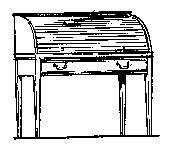Sheraton Furniture
English Period Furniture – Sheraton (Mahogany and Satinwood 1790-1806)
Thomas Sheraton was a trained Cabinetmaker and Carver, but was primarily a designer. He produced a book called “The Cabinetmaker and Upholsterers’ Drawing Book.
Sheraton continued to use Mahogany as his timber, but preferred satinwood, rosewood or painted finishes for his lighter drawing room furniture. He had a passion for mechanical parts and designed many types of secretaire or bureau. For example open a top drawer to reveal a writing surface, which then opened or slid back to provide access to drawers or pigeon holes. Carving basically disappeared.

Tambour Front Roll Writing Desk

Spade toe on chair leg
Sheraton Furniture Features
- Kept chair backs with straight lines and square shapes.
- Kept backs as open as possible.
- Single cross rails, vertical uprights and trellis effect.
- Tapered legs including spade toe.
- Turned legs with reeding became a fashionable form of decoration.
- Shield back with straight top.
- Known for many complicated mechanical actions, secret compartments, concealed drawers, sofa into beds or bed settee.
- Six legged sideboard – straight front with convex ends.
- Brass rods including candle stand.
- Sewing table.
- Introduced the tambour top or roll top desk, tambour front, roll top.
- Serpentine front chest of drawers.
More information on Styles and Periods of Interior Decorating
Styles and Periods
Furniture History
Decorating Styles
Period Decoration
What is Style?
